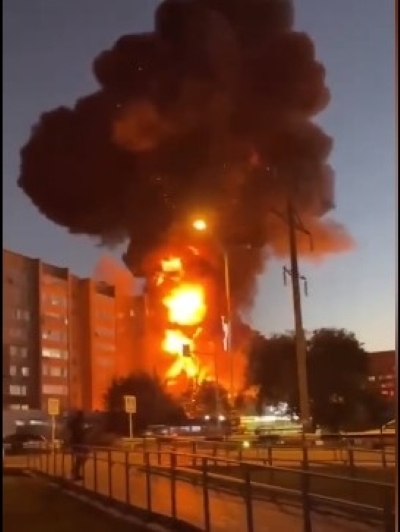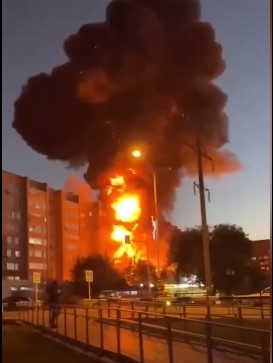Iran’s Deadly Drones Support Russia’s Invasion of Ukraine

(Twitter image) Russia fired an Iranian Shahed-136 drone at this civilian target in Ukraine.
by Ioannis E. Kotoulas
IPT News
October 19, 2022
 (Twitter image) Russia fired an Iranian Shahed-136 drone at this civilian target in Ukraine. (Twitter image) Russia fired an Iranian Shahed-136 drone at this civilian target in Ukraine. |
Iran is becoming an accomplice to Russia’s ongoing invasion of Ukraine by supplying Moscow with drones used in deadly attacks against civilians and infrastructure. It also is dispatching personnel to occupied regions of Ukraine to assist invading Russian forces. Iran also is testing the capabilities of its weaponry for future attacks against its opponents.
Russia invaded Ukraine in late February. It conducted a series of drone and missile strikes Monday targeting densely populated Ukrainian cities and critical infrastructure throughout. At least five people were killed and many wounded. Two more people were killed on a new attack on Tuesday.
Ukrainian officials said the attacks came from Iranian-made drones, specifically the one-way attack Shahed-136 model. According to Ukrainian media, five Shahed-136 drones struck infrastructure in Kyiv’s Shevchenkivskyi district, including the UkrEnergo (Ukrainian electricity transmission system operator) building, with the aim to plunge the city into darkness.
Videos of the attacks [here, here and here] show the Iranian drones used and the horrible devastation inflicted on Ukrainian civilians. Other videos [here and here] show the Iranian drones flying over the Ukrainian city choosing their targets. In another video, Ukrainian officers shoot down an Iranian drone.
Ukrainian President Volodymyr Zelensky last month accused Iran of enabling Russia’s terror campaign against Ukrainian civilians. “We are dealing with terrorists. Dozens of missiles. Iranian Shaheds […] They want panic and chaos.”
Ukrainian special services and other reports claim that the Russian army purposefully launched Shahed-136 Iranian drones over Uman in central Ukraine, attacking a Hasidic pilgrimage celebrating Rosh Hashanah. As many as 3,000 Hasidim were in Uman to celebrate.
“Planned acts of terrorism against Israeli citizens are one of the conditions for Iran’s transfer of drones to Russia. As you know, this is not the first example of cooperation between two terrorist countries. Not so long ago, a Ukrainian civilian plane was shot down in Iran, apparently by mistake. But the interests of the Kremlin can be seen behind this case,” Ukrainian special services told the website Babel.
Its use of Iranian munitions is a sign that Russia has exhausted most of its domestic stock of operational-tactical weapons, especially high-precision missiles and even artillery fire. Shahed-136s function as cruise missiles, enabling Russia to strike deep inside Ukraine.
According to the UK Defense Ministry, Russia has deployed Iranian manufactured drones against Ukraine since at least August. Iran’s Revolutionary Guard Corps (IRGC), designated by the United States as a Foreign Terrorist Organization, controls most of the drone force. In August, the IRGC confirmed joint exercises with Russia in deploying Iranian drones. Russia has ordered at least 2,400 Shahed-136 loitering munitions, according to Ukraine’s intelligence services.
Iranian kamikaze drones have also been delivered to Belarus, a state allied with Russia that allows attacks on Ukraine to be launched from its territory. Iran may see Ukraine as a testing ground for its drones and missiles for possible future attacks against Israel.
In addition to supplying the weapons, IRGC members may have traveled to Russian-held territories in Ukraine to help train Russian troops, according to an Oct. 12 report by the Institute for the Study of War. Britain’s Daily Mail reported that “up to 50” IRGC specialists were involved. According to the Ukrainian Resistance Center, the Iranian instructors directly control the launch of drones on civilian targets in Ukraine.
Ukraine stripped Iranian Ambassador Manouchehr Moradi’s accreditation and reduced the number of diplomatic personnel.
Iranian denial and U.S. response
Russia’s use of Iranian drones is a clear violation of UN Security Council Resolution 2231, the U.S. State Department said. The resolution, intricately linked to the progress of Iran’s nuclear program, explicitly prohibits the transfer of military technology.
The Iranian drone army has been used to supply weapons to Hamas, Hizballah and the Palestinian Islamic Jihad. They even threaten Israeli sea drilling projects.
Iran continues to deny its involvement in Ukraine despite the fact that its drones have been undeniably identified in the deadly attacks. “The published news about Iran providing Russia with drones has political ambitions and it’s circulated by western sources,” said Iranian Foreign Ministry spokesman Nasser Kanaani. “We have not provided weaponry to any side of the countries at war.”
“We have defense cooperation with Russia, but our policy on the Ukraine war is against sending weapons to the conflicting sides and support an end to the war and the people’s displacement,” Iranian Foreign Minister Hossein Amirabdollahian claimed during a telephone conversation with European Union (EU) High Representative for Foreign Affairs and Security Policy Josep Borrell. At the same time, according to a Reuters report, Iranian officials admit that they have pledged surface-to-surface missiles to Russia which will be soon dispatched.
The European Union responded to the Kyiv attack by promising additional sanctions against Iran.
The Biden administration condemned Iran’s “lies” about Ukrainian involvement and pledged to continue to enforce U.S. sanctions against both Russia and Iran. “We have been warning since July … that Iran was planning to sell UAVs [unmanned aerial vehicles] to Russia for use against Ukraine….There is extensive proof of their use by Russia against both military and civilian targets there,” White House Press Secretary Karine Jean-Pierre told reporters Monday. “You all have seen as well the reports this morning of what appear to be an Iranian drone strike in downtown Kyiv, yet Iran continues to lie about this. They have not been truthful about this and deny providing weapons to Russia for use in Ukraine. Meanwhile, according to these new reports, Iran is considering selling more destructive weapons to support an invasion they claim to oppose.”
“That’s what we’ll do from here,” Jean-Pierre said, “make it harder for Iran to sell these weapons to Russia, and we’ll stand with our partners throughout the region against that Iranian threat.
Russia’s invasion is stalling. Unable to achieve its strategic goals, and having suffered important setbacks since August, including the loss of captured territory, a failed mobilization and a humiliating destruction of the Kerch Bridge, Russia is now changing its tactics. It is resorting to terror campaigns of bombardment, prioritizing psychological terror effects on Ukraine over tangible battlefield effects. Over the last week, Russia has destroyed almost a third of Ukraine’s power stations ahead of the coming winter.
After multiple attacks on Ukrainian cities and troops the last eight months, Russia is now running out of high-precision weapons. To compensate for this disadvantage, Russia is resorting to cheap, but deadly drone technology and is increasingly dependent on Iranian-made “kamikaze” drones.
It remains to be seen whether the Biden administration and the European Union are up to the task of taking on increased Iranian interference and assistance of the Russian aggression against Ukraine. After this week’s gruesome attacks, the United States and NATO allies are rushing to deliver advanced air defense systems that Ukraine has been seeking for months.
Iranian state terrorism aligns with Russian terror tactics at the war front and the cities of Ukraine, a nation under attack and in dire distress for months.
 IPT Senior Fellow Ioannis E. Kotoulas (Ph.D. in History, Ph.D. in Geopolitics) is Adjunct Lecturer in Geopolitics at the University of Athens, Greece. His latest book is Geopolitics of the War in Ukraine.
IPT Senior Fellow Ioannis E. Kotoulas (Ph.D. in History, Ph.D. in Geopolitics) is Adjunct Lecturer in Geopolitics at the University of Athens, Greece. His latest book is Geopolitics of the War in Ukraine.
Related Topics: Ioannis E. Kotoulas, Iran, drones, Shahed-136, IRGC, Ukraine war, sanctions, Volodymyr Zelensky, Institute for the Study of War, Ukrainian Resistance Center, Manouchehr Moradi, Nasser Kanaani, Hossein Amirabdollahian, Josep Borrell, Karine Jean-Pierre















